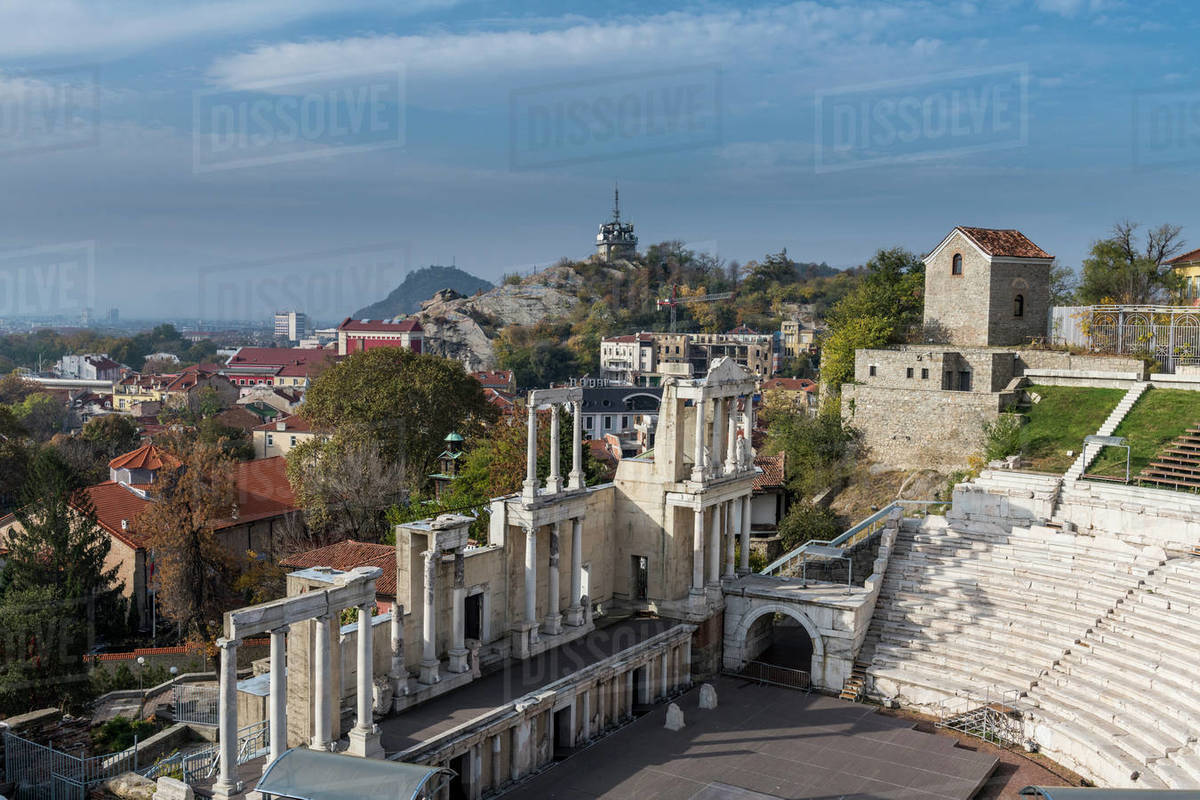Ever heard of a city that’s been thriving for eight thousand years? That’s Plovdiv, Bulgaria, a place where history isn’t just in textbooks – it’s alive in the streets. From its Neolithic roots as a Thracian settlement to its vibrant present, Plovdiv is a time-travel trip waiting to happen. Explore ancient ruins like Nebet Tepe, marvel at Roman mosaics, and soak up the energy of a city where past and present intertwine seamlessly.
Plovdiv’s Ancient Beginnings
Whispers of the Neolithic Era
Plovdiv’s story begins in the 6th millennium BC, a time shrouded in mystery yet illuminated by archaeological discoveries. Pottery fragments and the ghostly outlines of dwellings suggest a thriving Neolithic community drawn to the fertile Thracian plain and the life-giving Maritsa River. Imagine these early inhabitants, their lives interwoven with the very landscape that cradles the modern city.
The Rise of Philippopolis
Centuries later, in the 4th century BC, King Philip II of Macedon, father of Alexander the Great, recognized Plovdiv’s strategic importance. He not only conquered the city but left his mark by renaming it Philippopolis. This marked a turning point, transforming Plovdiv into a major Thracian hub. The city likely buzzed with commerce, the rumble of chariots, and the whispers of political intrigue within the king’s court.
A Golden Age Under Roman Rule
The Romans, with their keen eye for strategic locations, seamlessly integrated Philippopolis into their vast empire. As a provincial capital, the city flourished. The magnificent ancient stadium and the hillside theater stand as silent witnesses to Roman grandeur, probably hosting gladiatorial contests, athletic feats, and dramatic spectacles. These structures likely played a vital role in reinforcing Roman authority and influence within the region.
Byzantine Frontier and a Testament of Faith
With the decline of the Roman Empire, Philippopolis found itself on the Byzantine frontier, a strategically important city caught in the ebb and flow of power struggles. This era, while less documented, speaks to Plovdiv’s resilience. Imagine the city enduring numerous sieges, its walls bearing witness to history’s relentless march. Within these walls, the 4th-century Bishop’s Basilica emerged, a testament to the growing influence of Christianity. Its intricate mosaic floors, depicting biblical scenes and geometric patterns, offer a glimpse into the city’s spiritual life. Some scholars suggest the basilica served as a central gathering place for the early Christian community, further solidifying Plovdiv’s importance as a spiritual hub.
From Philippopolis to Plovdiv: A City Transformed
Plovdiv’s journey didn’t end with the Romans or Byzantines. Under Ottoman rule, the city, known as Philibé, absorbed new cultural influences. Later, during the Bulgarian Revival period, Plovdiv became a symbol of national identity. The brightly colored houses of Old Town stand as testaments to this era. Today, Plovdiv thrives as a vibrant blend of its multifaceted past, a city where ancient ruins and modern life coexist harmoniously. Discover the charming coastal village of Netley Hampshire UK and escape to the tranquil beauty of the Brecon Beacons with our guide to the best places to stay in Brecon.
When Did Philippopolis Become Plovdiv?
Plovdiv’s name has evolved over millennia, reflecting the city’s complex history. From its Thracian roots as Pulpudeva to the Macedonian influence of Philippopolis, the Roman Trimontium, the Ottoman Philibé, and finally, Plovdiv, the city’s name reflects its journey through time.
From Pulpudeva to Philippopolis: A City Conquered
Before 341 BC, the Thracian settlement of Pulpudeva thrived on the three hills overlooking the Maritsa River. In 342/341 BC, Philip II of Macedon conquered the city, renaming it Philippopolis. This marked a significant shift, integrating the city into the Hellenistic world. Evidence suggests the Thracians briefly retook the city, possibly renaming it Eumolpia. This period, though less documented, highlights the contested nature of the city’s early history.
Roman Trimontium and Beyond
Under Roman rule, Philippopolis became known as Trimontium, “Three Hills.” As the capital of the Thracian province, the city further cemented its importance. Later, under Byzantine and Ottoman rule, the city’s fortifications were strengthened, and its cultural landscape further diversified. The Ottoman name, Philibé, reflects this period of influence.
The Evolution to Plovdiv
The transition from Philippopolis/Philibé to Plovdiv was a gradual process, a linguistic evolution rather than a single event. The name “Plovdiv” likely derives from the original Thracian “Pulpudeva,” morphing through languages and pronunciations over centuries. Pinpointing the exact moment of transition remains a challenge for historians. Ongoing research seeks to uncover the specific circumstances and timing of this shift, a crucial missing piece in Plovdiv’s historical puzzle.
Is Plovdiv the Oldest City in Europe?
Plovdiv’s claim as one of Europe’s oldest continuously inhabited cities rests on its remarkable 8,000-year history. From Neolithic beginnings to its modern vibrancy, Plovdiv’s story is one of uninterrupted human presence.
Eight Millennia of Habitation
Archaeological findings, including pottery fragments and dwelling remnants, date back to the Neolithic era (7th millennium BC). This testifies to Plovdiv’s ancient origins and its enduring appeal as a place of settlement. Long before Rome’s rise, the Thracians established Eumolpias, a strategically located settlement eventually conquered and renamed Philippopolis by Philip II of Macedon. This unbroken thread of habitation, through Thracian, Hellenistic, Roman, Byzantine, and Ottoman periods, underscores Plovdiv’s claim.
A Continuous Narrative
Roman historians, like Ammianus Marcellinus, documented Philippopolis, solidifying its place in ancient history. The Byzantine walls, still standing, whisper tales of resilience and the city’s strategic importance. The Ottoman era added another layer to Plovdiv’s multicultural tapestry.
The “Oldest” City Debate
While Plovdiv’s claim as the oldest continuously inhabited city in Europe is compelling, the definitive title of “oldest” is a complex issue. Other contenders, such as Athens and Matera, have their own compelling historical narratives. The definition of “city” and “continuous habitation” itself is subject to interpretation. This ongoing debate fuels further research and continues to captivate historians and archaeologists.
How Much is a Beer in Plovdiv, Bulgaria?
After exploring Plovdiv’s historical wonders, you’ll likely want a refreshing beer. Fortunately, Plovdiv offers a range of options for every budget.
Local Brews and International Favorites
Domestic beers typically cost between 2.50 and 4.00 BGN (approximately $1.40 – $2.25 USD), while imported beers range from 3.50 to 5.50 BGN ($2.00 – $3.10 USD). These prices are subject to change and may vary depending on the establishment. Craft beer enthusiasts will also find exciting local and international brews in Plovdiv’s growing craft beer scene, with prices similar to imported options.
Enjoying Plovdiv’s Pub Culture
Beyond the price, enjoying a beer in Plovdiv is about experiencing the city’s vibrant pub culture. Imagine yourself in a cozy Kapana district pub, surrounded by lively conversation and the charm of ancient cobblestone streets.
Remember, the legal drinking age in Bulgaria is 18, and enforcement is generally strict. Non-alcoholic beers are widely available. So, raise a glass (alcoholic or not) to Plovdiv – a city where history, culture, and the simple pleasure of a beer create an unforgettable experience.
- Discover Long Black Pepper: Flavor & Health Benefits - April 25, 2025
- Shocking Twists: The Grownup Review: Unreliable Narration - April 25, 2025
- A Quiet Place Book vs Movie: A Deep Dive - April 25, 2025

















1 thought on “Plovdiv: A Journey Through 6,000 Years of History from Philippopolis to Today”
Comments are closed.